Overview on Transactive Energy—Advantages and Challenges for Weak Power Grids
Abstract
1. Introduction
2. Transactive Energy Market Topologies
2.1. Peer to Peer
2.2. Community-Based Market Topology
2.3. Hybrid Market
3. Interoperability Layer
3.1. Business Layer
3.2. Function Layer
3.3. Information Layer
3.4. Communication Layer
- The smart grid must manage the quality-of-service (QoS), reliability, and security requirements, applying current communication standards.
- A technical document must be written with the service level of availability, resilience, and denial-of-service (DoS) in the communication service.
- The communication technologies applicable to different sub-networks on the communications architecture must be defined.
3.5. Component Layer
4. Optimization Techniques in TE
4.1. Game Theory
- Non-cooperative games: These games study the optimization process in each participant’s decision to maximize their interests, without any communication or coordination in the actions of the players involved. They can be divided into static and dynamic games. They are used as a strategy in the pricing of electricity by the time of use [26].
- Evolutionary Game: These games consist of a large number of players who repeatedly play a particular game against each other, to find the best strategy based on their opponent’s past behavior. They are used to model transactions between private companies and citizens where many unknown factors exist [27].
4.2. Decomposition-Lagrange and Karush–Kuhn–Tucker Methods
4.3. Networked Optimization
4.4. Agent-Based Optimization Method
4.5. Blockchain as a Technology Application in Transactive Energy
- Identify supply and demand: Participants within the network identify their energy supply and demand requirements.
- Create a transaction: A participant generates a transaction, specifying the desired amount of energy and relevant details.
- Propagate the transaction: The transaction is broadcasted across the blockchain network, reaching participating nodes and miners.
- Validate the transaction: Miners verify the transaction’s legitimacy by confirming the sender’s adequate funds and ensuring the offer meets the required criteria.
- Include in a block: Once validated, the transaction is grouped with other transactions into a block.
- Verify the block: Miners compete to solve a cryptographic challenge (proof of work) for the opportunity to add the block to the existing blockchain.
- Confirm the transaction: As additional blocks are appended to the blockchain, the transaction becomes confirmed and nearly irreversible. The number of confirmations required may vary.
- Execute the transaction: Once confirmed, the energy transaction is executed, involving the physical transfer of energy, adjustments to the supply, or financial transactions based on predefined smart contract agreements.
5. Summary and Final Discussions
6. Conclusions
Author Contributions
Funding
Data Availability Statement
Acknowledgments
Conflicts of Interest
Nomenclature
| CEN | European Committee for Standardization |
| CENELEC | European Committee for Electrotechnical Standardization |
| DER | Distributed Energy Resource |
| DG | Distributed Generator |
| DoS | Denial-of-service |
| DSO | Distribution system operator |
| ETSI | European Telecommunications Standards Institute |
| KKT | Karush–Kuhn–Tucker |
| P2P | Peer-to-peer |
| QoS | Quality-of-service |
| SGAM | Smart Grid Architecture Model |
| TE | Transactive Energy |
References
- National Institute of Standards and Technology, U.S Department of Commerce. Transactive Energy: An Overview; National Institute of Standards and Technology, U.S Department of Commerce: Gaithersburg, MD, USA, 2022.
- Kwasinski, A.; Andrade, F.; Castro-Sitiriche, M.J.; O’Neill-Carrillo, E. Hurricane Maria effects on Puerto Rico electric power infrastructure. IEEE Power Energy Technol. Syst. J. 2019, 6, 85–94. [Google Scholar] [CrossRef]
- Dudjak, V.; Neves, D.; Alskaif, T.; Khadem, S.; Pena-Bello, A.; Saggese, P.; Bowler, B.; Andoni, M.; Bertolini, M.; Zhou, Y.; et al. Impact of local energy markets integration in power systems layer: A comprehensive review. Appl. Energy 2021, 301, 117434. [Google Scholar] [CrossRef]
- Sun, H.; Guo, Q.; Qi, J.; Ajjarapu, V.; Bravo, R.; Chow, J.; Li, Z.; Moghe, R.; Nasr-Azadani, E.; Tamrakar, U.; et al. Review of challenges and research opportunities for voltage control in smart grids. IEEE Trans. Power Syst. 2019, 34, 2790–2801. [Google Scholar] [CrossRef]
- Naqvi, S.B.Q.; Singh, B. A PV-Battery System Resilient to Weak Grid Conditions With Regulated Power Injection and Grid Supportive Features. IEEE Trans. Sustain. Energy 2022, 13, 1408–1419. [Google Scholar] [CrossRef]
- Arraño-Vargas, F.; Shen, Z.; Jiang, S.; Fletcher, J.; Konstantinou, G. Challenges and Mitigation Measures in Power Systems with High Share of Renewables—The Australian Experience. Energies 2022, 15, 429. [Google Scholar] [CrossRef]
- Chen, Y.; Zhao, C. Review of energy sharing: Business models, mechanisms, and prospects. IET Renew. Power Gener. 2022, 16, 2468–2480. [Google Scholar] [CrossRef]
- Parag, Y.; Sovacool, B.K. Electricity market design for the prosumer era. Nat. Energy 2016, 1, 1–6. [Google Scholar] [CrossRef]
- Sousa, T.; Soares, T.; Pinson, P.; Moret, F.; Baroche, T.; Sorin, E. Peer-to-peer and community-based markets: A comprehensive review. Renew. Sustain. Energy Rev. 2019, 104, 367–378. [Google Scholar] [CrossRef]
- Nizami, S.; Tushar, W.; Hossain, M.; Yuen, C.; Saha, T.; Poor, H.V. Transactive energy for low voltage residential networks: A review. Appl. Energy 2022, 323, 119556. [Google Scholar] [CrossRef]
- Rahimi, F.; Mokhtari, S. Open Access Technology International (OATI). A New Distribution System Operator Construct; Open Access Technology International (OATI): Minneapolis, MN, USA, 2014. [Google Scholar]
- Forfia, D.; Knight, M.; Melton, R. The View from the Top of the Mountain: Building a Community of Practice with the GridWise Transactive Energy Framework. IEEE Power Energy Mag. 2016, 14, 25–33. [Google Scholar] [CrossRef]
- Rahimi, F.A.; Mokhtari, S. Distribution management system for the grid of the future: A transactive system compensating for the rise in distributed energy resources. IEEE Electrif. Mag. 2018, 6, 84–94. [Google Scholar] [CrossRef]
- Martins, J.F.; Romero-Cadaval, E.; Vinnikov, D.; Malinowski, M. Transactive Energy: Power Electronics Challenges. IEEE Power Electron. Mag. 2022, 9, 20–32. [Google Scholar] [CrossRef]
- Bruinenberg, J.; Colton, L.; Darmois, E.; Dorn, J.; Doyle, J.; Elloumi, O.; Englert, H.; Forbes, R.; Heiles, J.; Hermans, P.; et al. CEN-CENELEC-ETSI smart grid co-ordination group smart grid reference architecture. CEN CENELEC ETSI Tech. Rep. 2012, 23, 24. [Google Scholar]
- Stepaniuk, V.; Pillai, J.R.; Bak-Jensen, B.; Padmanaban, S. Estimation of Energy Activity and Flexibility Range in Smart Active Residential Building. Smart Cities 2019, 2, 471–495. [Google Scholar] [CrossRef]
- Nizami, M.S.H.; Hossain, M.J.; Fernandez, E. Multiagent-based transactive energy management systems for residential buildings with distributed energy resources. IEEE Trans. Ind. Inform. 2019, 16, 1836–1847. [Google Scholar] [CrossRef]
- Bokkisam, H.R.; Singh, S.; Acharya, R.M.; Selvan, M. Blockchain-based peer-to-peer transactive energy system for community microgrid with demand response management. CSEE J. Power Energy Syst. 2021, 8, 198–211. [Google Scholar]
- Nunna, H.K.; Srinivasan, D. Multiagent-based transactive energy framework for distribution systems with smart microgrids. IEEE Trans. Ind. Inform. 2017, 13, 2241–2250. [Google Scholar] [CrossRef]
- Pingkuo, L.; Huan, P.; Zhiwei, W. Orderly-synergistic development of power generation industry: A China’s case study based on evolutionary game model. Energy 2020, 211, 118632. [Google Scholar] [CrossRef]
- Khorasany, M. Market Design for Peer-to-Peer Energy Trading in a Distribution Network with High Penetration of Distributed Energy Resources. Ph.D. Thesis, Queensland University of Technology, Brisbane, Australia, 2020. [Google Scholar]
- Song, M.; Cai, Y.; Gao, C.; Chen, T.; Yao, Y.; Ming, H. Transactive energy in power distribution systems: Paving the path towards cyber-physical-social system. Int. J. Electr. Power Energy Syst. 2022, 142, 108289. [Google Scholar] [CrossRef]
- IEEE Std 802.3-2022; IEEE Standard for Ethernet. Revision of IEEE Std 802.3-2018. IEEE: New York, NY, USA, 2022; pp. 1–7025. [CrossRef]
- Shoham, Y.; Leyton-Brown, K. Multiagent Systems: Algorithmic, Game-Theoretic, and Logical Foundations; Cambridge University Press: Cambridge, UK, 2008. [Google Scholar]
- Malik, S.; Duffy, M.; Thakur, S.; Hayes, B.P.; Breslin, J.G. A priority-based approach for peer-to-peer energy trading using cooperative game theory in local energy community. Int. J. Electr. Power Energy Syst. 2022, 137, 107865. [Google Scholar] [CrossRef]
- Marzband, M.; Javadi, M.; Domínguez-García, J.L.; Mirhosseini Moghaddam, M. Non-cooperative game theory based energy management systems for energy district in the retail market considering DER uncertainties. IET Gener. Transm. Distrib. 2016, 10, 2999–3009. [Google Scholar] [CrossRef]
- Quijano, N.; Ocampo-Martinez, C.; Barreiro-Gomez, J.; Obando, G.; Pantoja, A.; Mojica-Nava, E. The Role of Population Games and Evolutionary Dynamics in Distributed Control Systems: The Advantages of Evolutionary Game Theory. IEEE Control. Syst. Mag. 2017, 37, 70–97. [Google Scholar]
- Navon, A.; Ben Yosef, G.; Machlev, R.; Shapira, S.; Roy Chowdhury, N.; Belikov, J.; Orda, A.; Levron, Y. Applications of game theory to design and operation of modern power systems: A comprehensive review. Energies 2020, 13, 3982. [Google Scholar] [CrossRef]
- Lei, J.; Liu, Z.; Ma, L.; Wang, L. A transactive energy framework for multi-energy management of smart communities. In Proceedings of the 2019 IEEE Sustainable Power and Energy Conference (iSPEC), Beijing, China, 21–23 November 2019; pp. 2176–2181. [Google Scholar]
- Pan, D.; Xie, Y.; Zheng, B.; Wei, W.; Mei, S. An Equilibrium Model of Power System with Peer-to-Peer Energy Transaction. In Proceedings of the Chinese Control Conference, CCC, Shanghai, China, 26–28 July 2021; pp. 1687–1691. [Google Scholar] [CrossRef]
- Nezamabadi, H.; Vahidinasab, V. Arbitrage Strategy of Renewable-Based Microgrids via Peer-to-Peer Energy-Trading. IEEE Trans. Sustain. Energy 2021, 12, 1372–1382. [Google Scholar] [CrossRef]
- Bhand, I.; Debbarma, S. Transaction-Tracing Based Loss Allocation in Distribution Networks under TE System. IEEE Syst. J. 2021, 15, 5664–5673. [Google Scholar] [CrossRef]
- Bhand, I.; Debbarma, S.; Roy, S.D. Loss Allocation in Distribution Network involving Peer-to-Peer Energy Transactions. In Proceedings of the 2022 4th International Conference on Energy, Power and Environment (ICEPE), Shillong, India, 29 April–1 May 2022; pp. 1–6. [Google Scholar]
- Nikolaidis, A.I.; Charalambous, C.A.; Mancarella, P. A Graph-Based Loss Allocation Framework for Transactive Energy Markets in Unbalanced Radial Distribution Networks. IEEE Trans. Power Syst. 2019, 34, 4109–4118. [Google Scholar] [CrossRef]
- Rusek, K.; Suárez-Varela, J.; Mestres, A.; Barlet-Ros, P.; Cabellos-Aparicio, A. Unveiling the potential of Graph Neural Networks for network modeling and optimization in SDN. In Proceedings of the 2019 ACM Symposium on SDN Research, San Jose, CA, USA, 3–4 April 2019; pp. 140–151. [Google Scholar]
- Shiflet, A.B.; Shiflet, G.W. An introduction to agent-based modeling for undergraduates. Procedia Comput. Sci. 2014, 29, 1392–1402. [Google Scholar] [CrossRef]
- Wang, N.; Zhou, X.; Lu, X.; Guan, Z.; Wu, L.; Du, X.; Guizani, M. When energy trading meets blockchain in electrical power system: The state of the art. Appl. Sci. 2019, 9, 1561. [Google Scholar] [CrossRef]
- Gourisetti, S.N.G.; Widergren, S.E.; Mylrea, M.E.; Wang, P.; Borkum, M.I.; Randall, A.M.; Bhattarai, B.P. Blockchain Smart Contracts for Transactive Energy Systems; Pacific Northwest National Lab. (PNNL): Richland, WA, USA, 2019.
- Wongthongtham, P.; Marrable, D.; Abu-Salih, B.; Liu, X.; Morrison, G. Blockchain-enabled Peer-to-Peer energy trading. Comput. Electr. Eng. 2021, 94, 107299. [Google Scholar] [CrossRef]
- Zhao, Z.; Guo, J.; Luo, X.; Xue, J.; Lai, C.S.; Xu, Z.; Lai, L.L. Energy transaction for multi-microgrids and internal microgrid based on blockchain. IEEE Access 2020, 8, 144362–144372. [Google Scholar] [CrossRef]
- Wu, Y.; Wu, Y.; Guerrero, J.M.; Vasquez, J.C. Decentralized transactive energy community in edge grid with positive buildings and interactive electric vehicles. Int. J. Electr. Power Energy Syst. 2022, 135, 107510. [Google Scholar] [CrossRef]
- Gourisetti, S.N.G.; Sebastian-Cardenas, D.J.; Bhattarai, B.; Wang, P.; Widergren, S.; Borkum, M.; Randall, A. Blockchain smart contract reference framework and program logic architecture for transactive energy systems. Appl. Energy 2021, 304, 117860. [Google Scholar] [CrossRef]
- Chen, S.; Ping, J.; Yan, Z.; Li, J.; Huang, Z. Blockchain in energy systems: Values, opportunities, and limitations. Front. Energy 2022, 16, 9–18. [Google Scholar] [CrossRef]
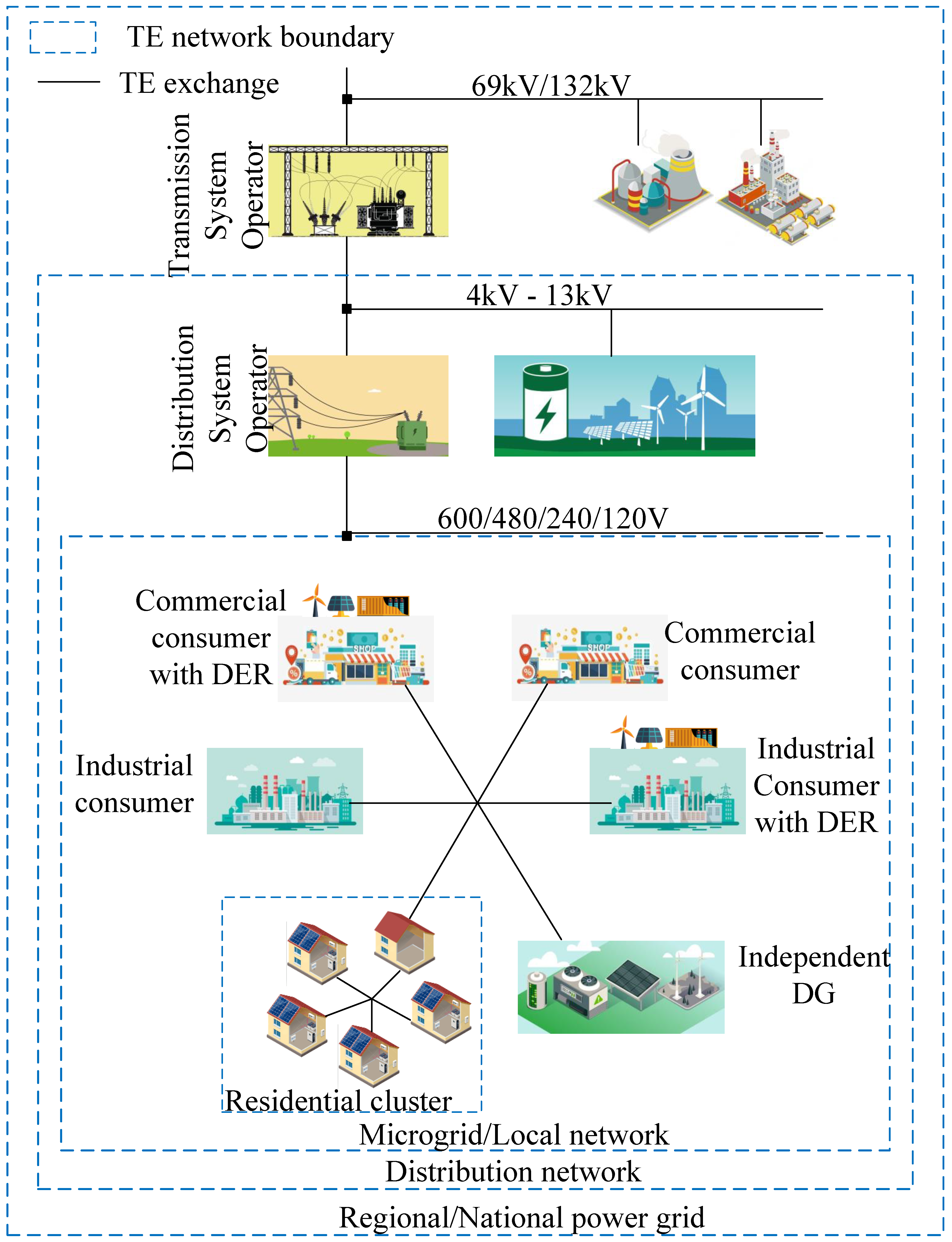
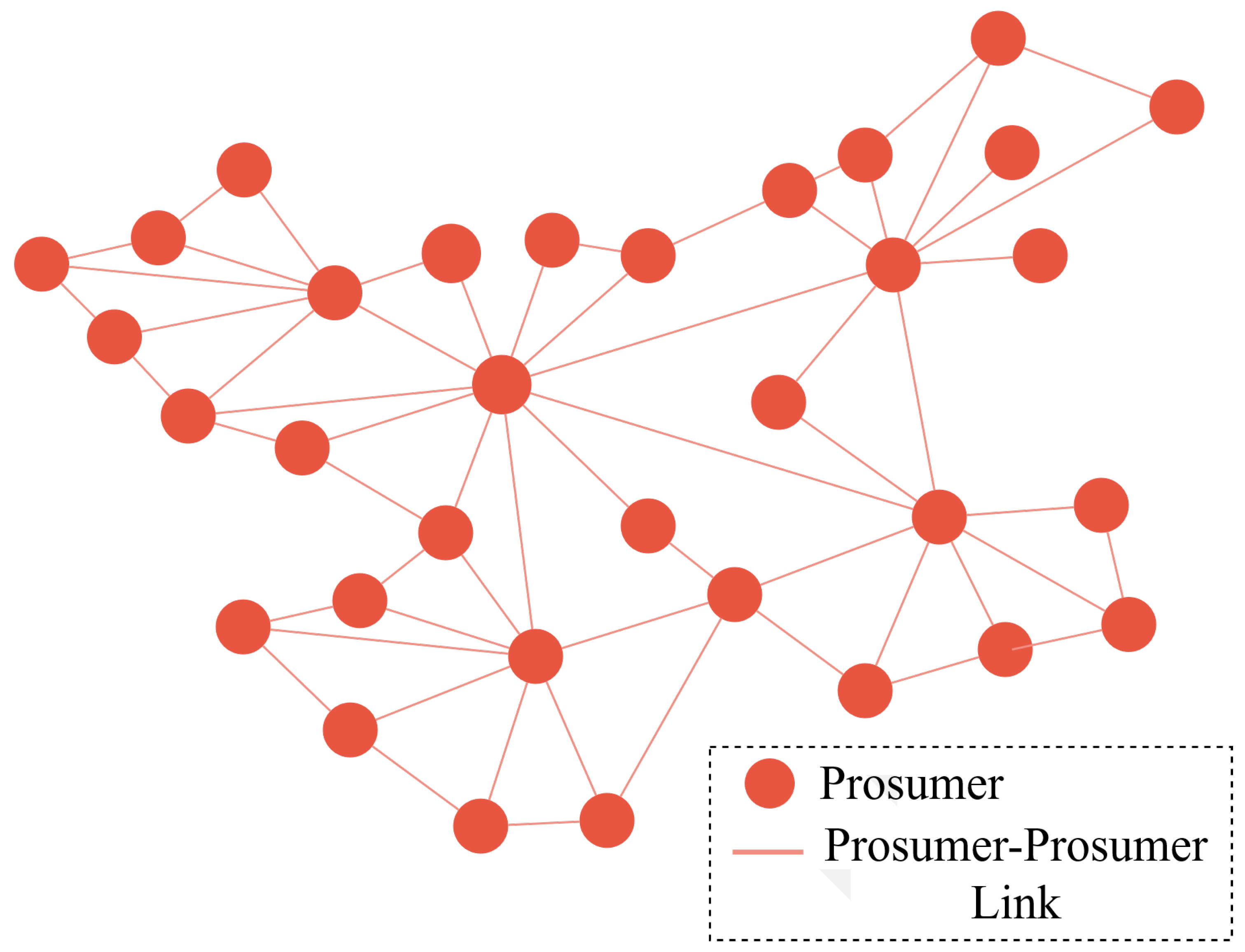
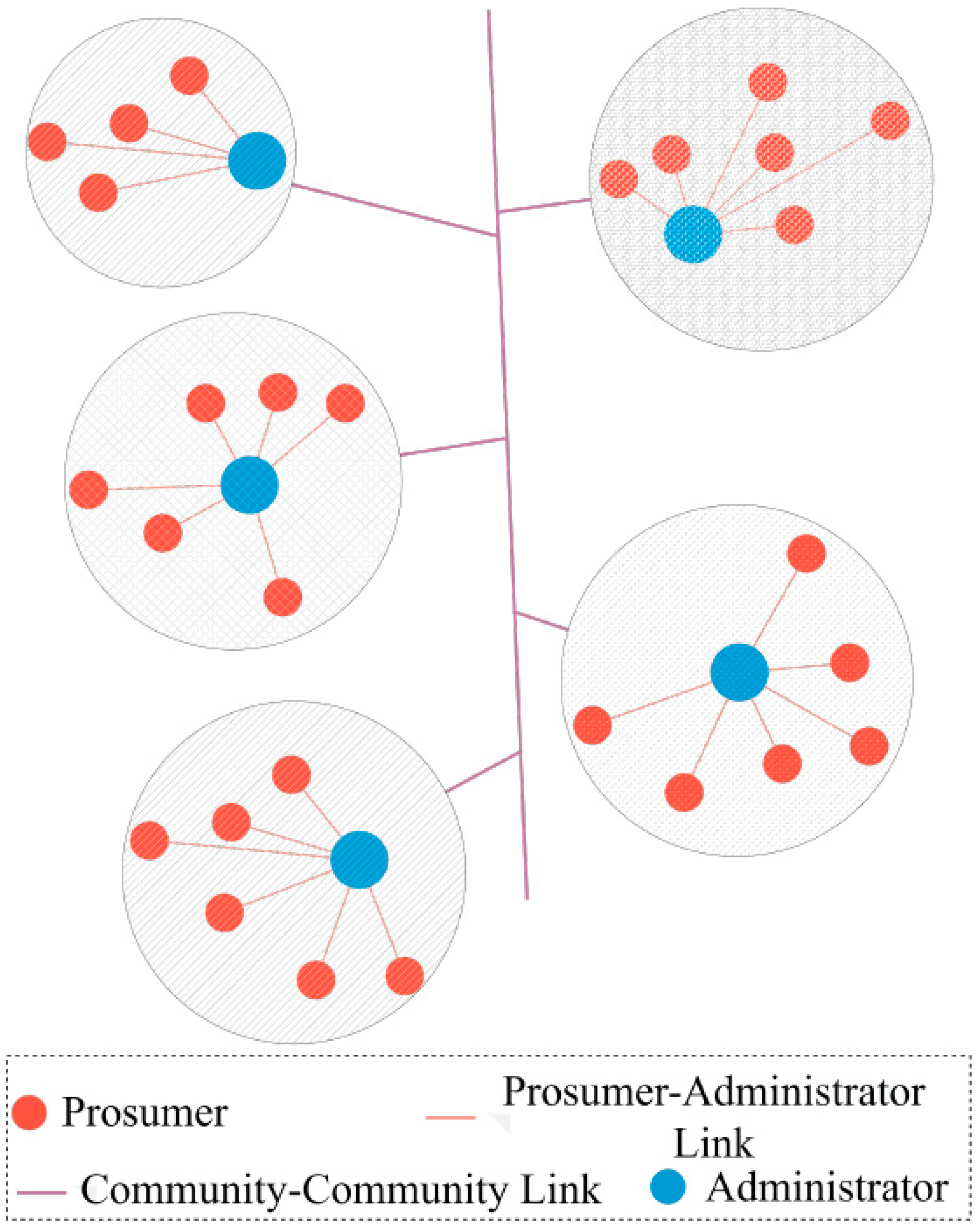
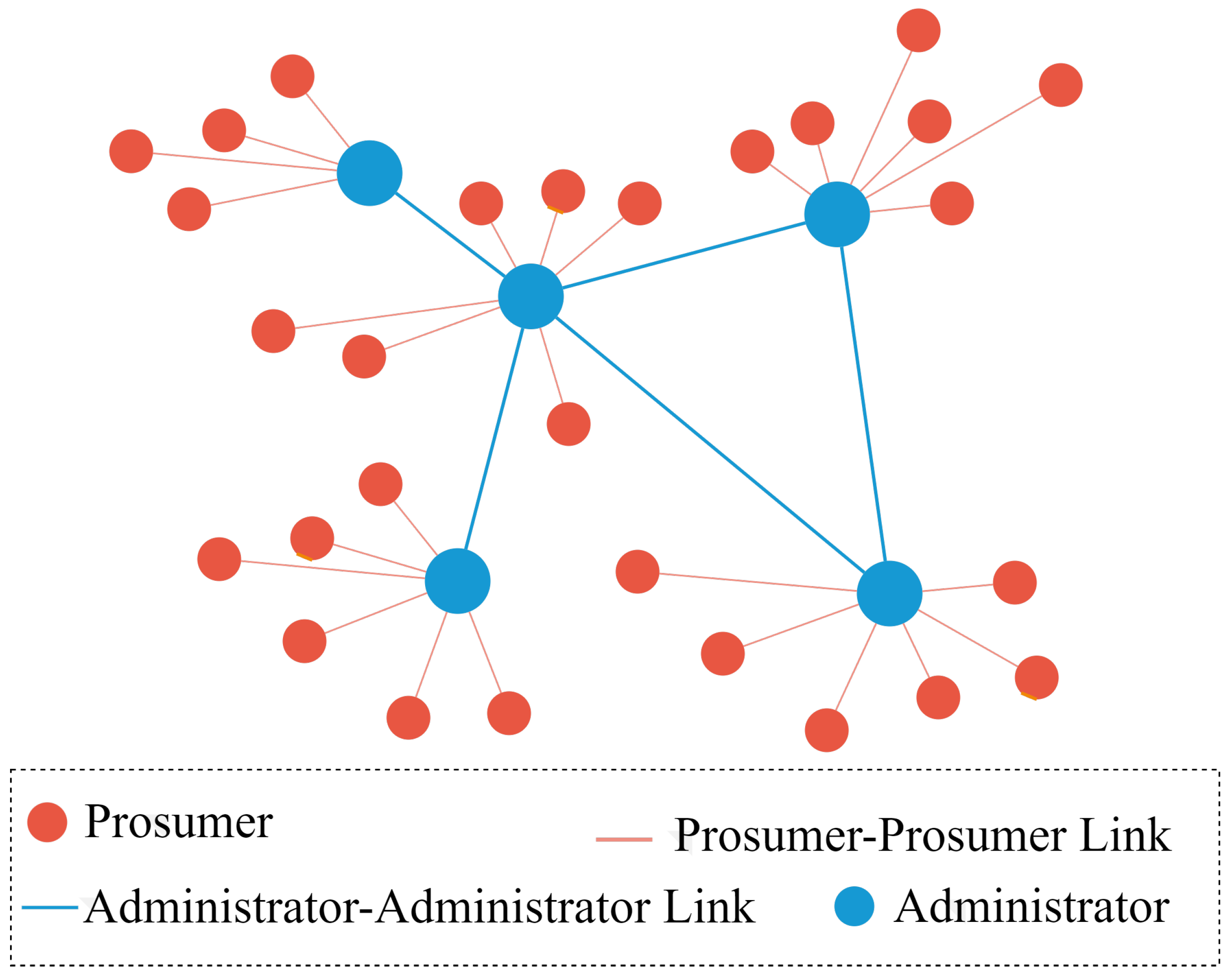
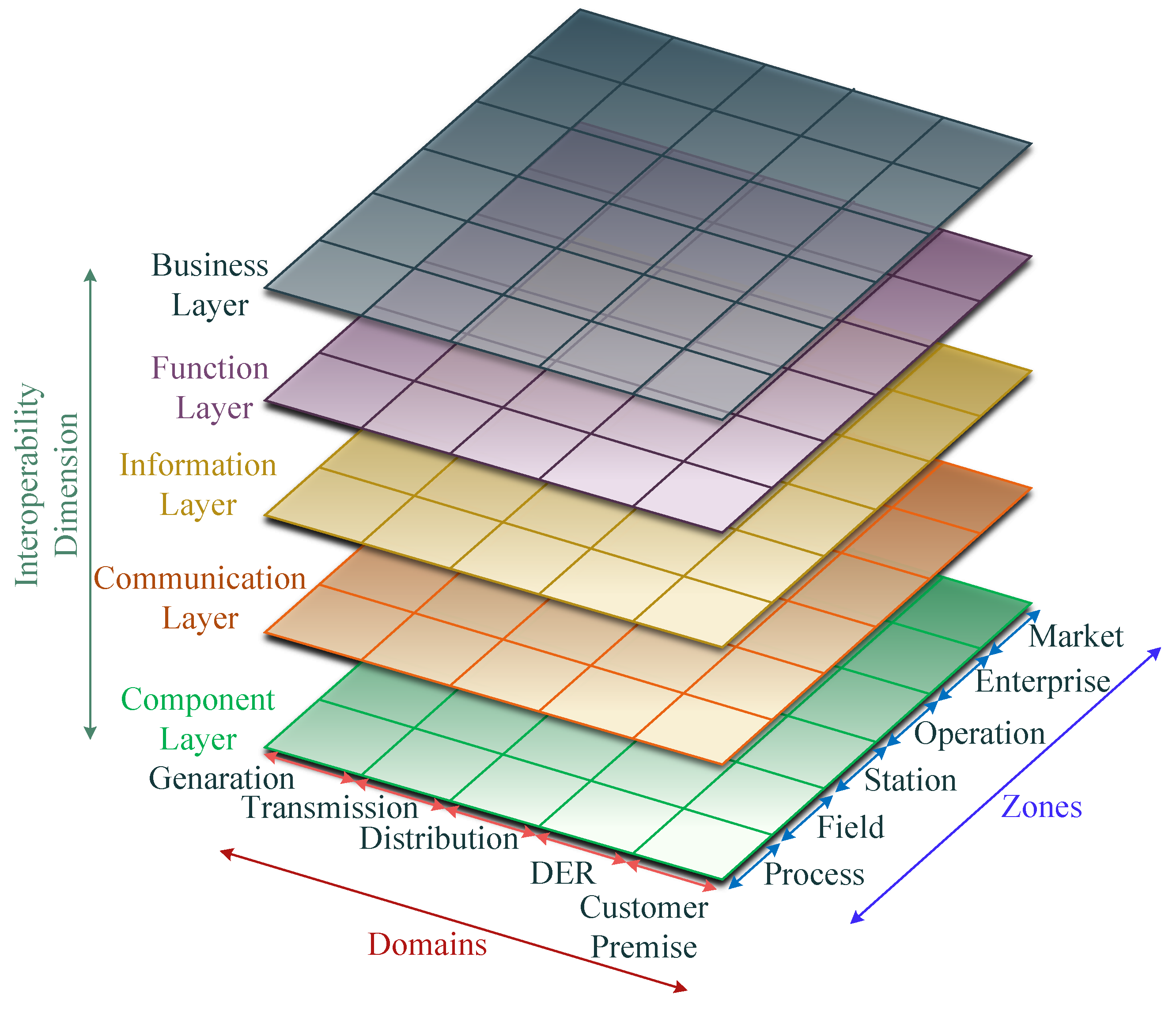
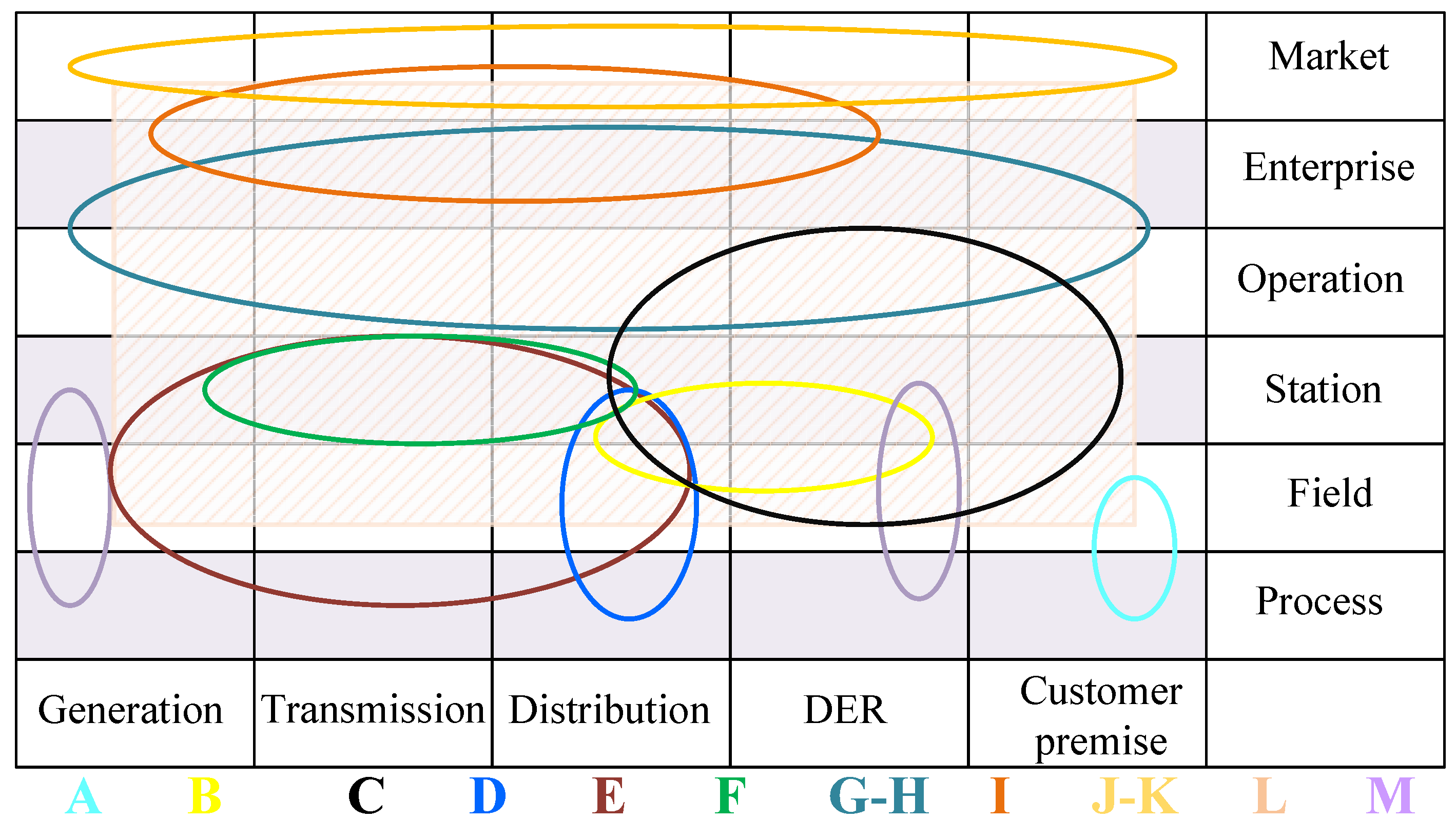

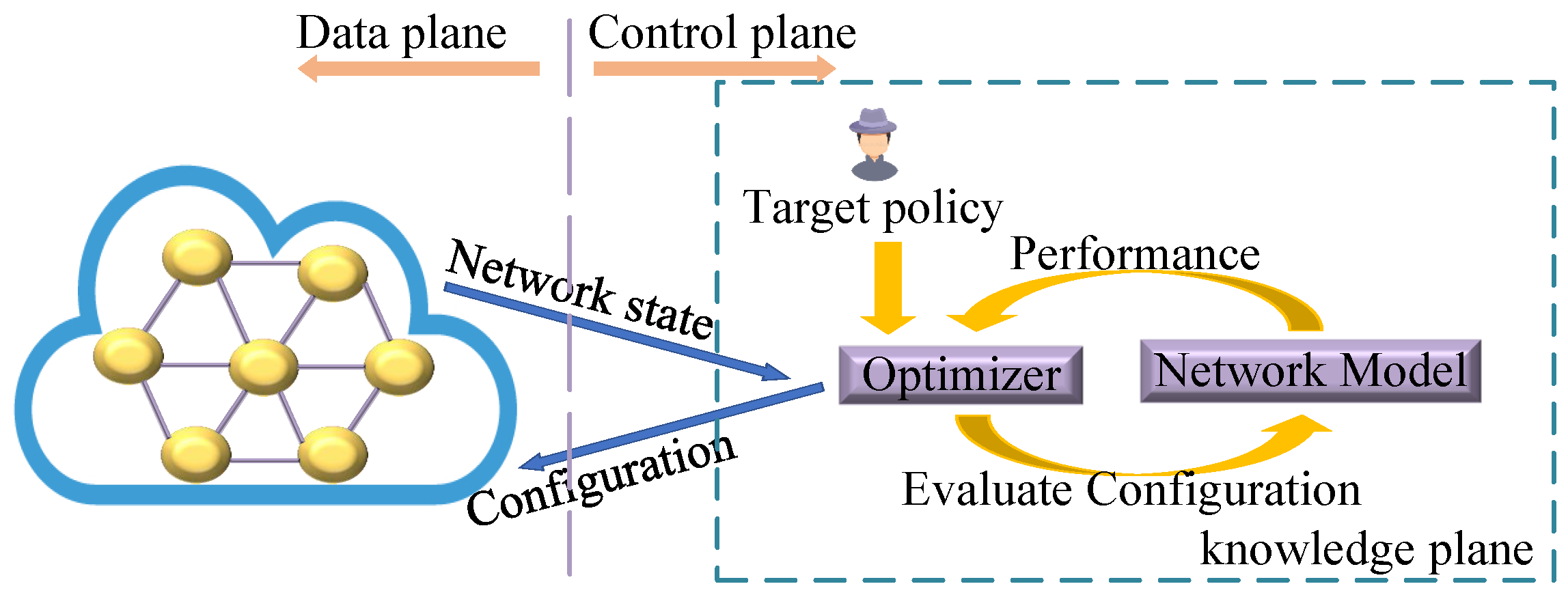

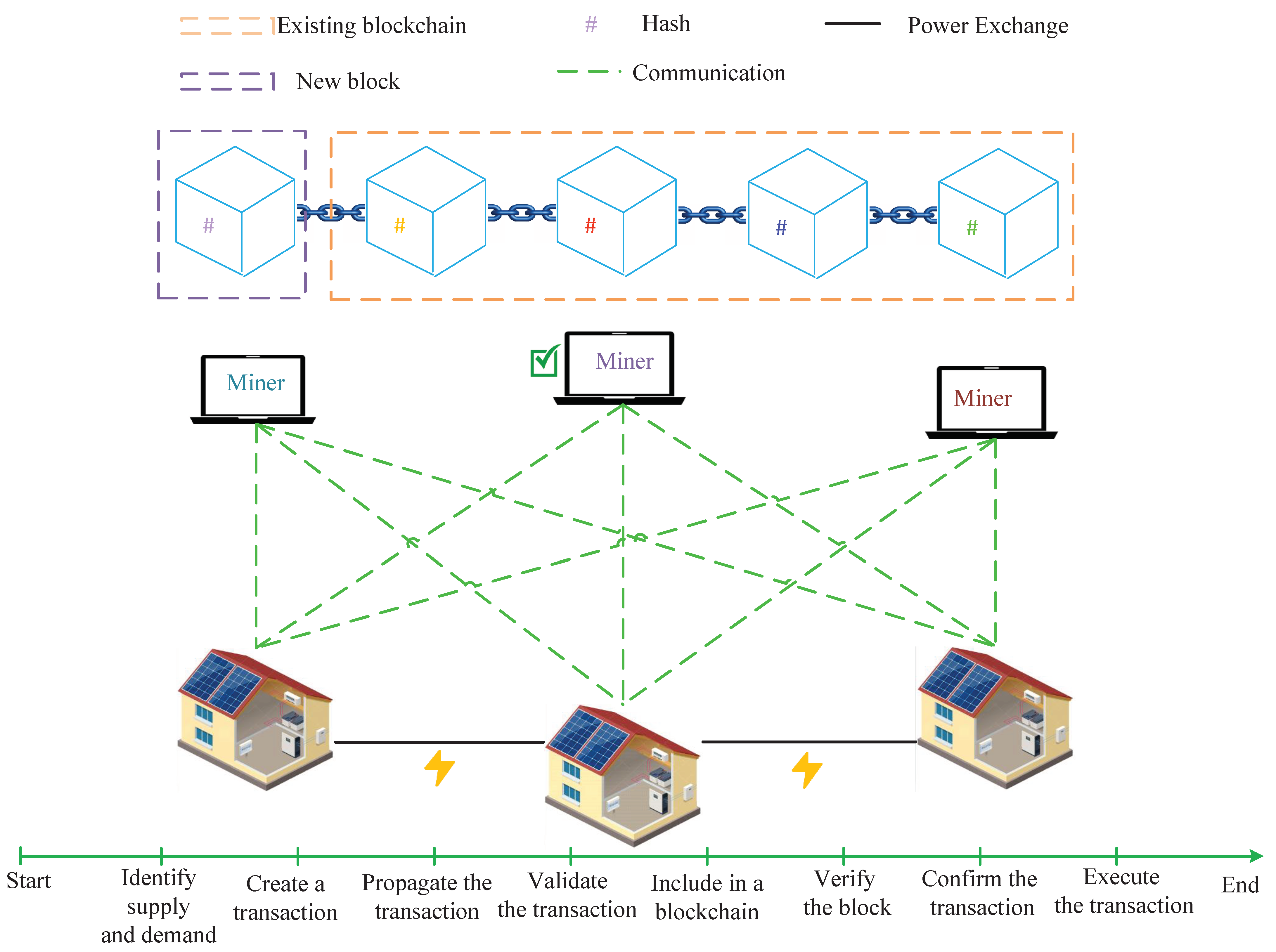
| Market Topology | Benefits | Challenges |
|---|---|---|
| Peer-to-peer, P2P, Full P2P [8,9,10,21] |
|
|
| Organized prosumer groups, Community-based market [8,9,10,21] |
|
|
| Prosumer-to-interconnected, hybrid P2P, hybrid [8,9,10] |
|
|
| Intersection | Subnetwork Name |
|---|---|
| A | Subscriber |
| B | Neighborhood |
| C | Field Area |
| D | Low-end intra-substation |
| E | Intra-substation |
| F | Inter-substation |
| G | Intra-Control Center |
| H | Enterprise |
| I | Balancing |
| J | Interchange |
| K | Trans-Regional |
| L | Wide and Metropolitan Area |
| M | Industrial Fieldbus Area |
| Game Method | Features | Application | Refs. |
|---|---|---|---|
| Cooperative | Mutual agreements between players, looking for Nash equilibrium | Generating companies, load serving entity, demand response providers. | [28] [24] [25] |
| Non-cooperative | Each player decides based on their interest without coordination with others | Trading electricity market with hybrid electric vehicles and batteries | [26] [28] |
| Evolutionary | Repetitive games to find the best strategy | Stability analysis of electricity markets, Power suppliers, consumers | [20] [28] |
| Optimization Technique | Market Topology | Features/Characteristic Application | ||
|---|---|---|---|---|
| 1 | 2 | 3 | ||
| Game Theory | 🗸 | 🗸 | 🗸 |
|
| Decomposition-KKT | 🗸 |
| ||
| Networked optimization | 🗸 | 🗸 | 🗸 |
|
| Agent-based optimization technique | 🗸 |
| ||
| Blockchain application | 🗸 | 🗸 | 🗸 |
|
Disclaimer/Publisher’s Note: The statements, opinions and data contained in all publications are solely those of the individual author(s) and contributor(s) and not of MDPI and/or the editor(s). MDPI and/or the editor(s) disclaim responsibility for any injury to people or property resulting from any ideas, methods, instructions or products referred to in the content. |
© 2023 by the authors. Licensee MDPI, Basel, Switzerland. This article is an open access article distributed under the terms and conditions of the Creative Commons Attribution (CC BY) license (https://creativecommons.org/licenses/by/4.0/).
Share and Cite
Garcia, Y.V.; Garzon, O.; Delgado, C.J.; Diaz, J.L.; Penagos, C.A.V.; Andrade, F.; Luna, A.C.; Hernandez, J.C. Overview on Transactive Energy—Advantages and Challenges for Weak Power Grids. Energies 2023, 16, 4607. https://doi.org/10.3390/en16124607
Garcia YV, Garzon O, Delgado CJ, Diaz JL, Penagos CAV, Andrade F, Luna AC, Hernandez JC. Overview on Transactive Energy—Advantages and Challenges for Weak Power Grids. Energies. 2023; 16(12):4607. https://doi.org/10.3390/en16124607
Chicago/Turabian StyleGarcia, Yuly V., Oscar Garzon, Carlos J. Delgado, Jan L. Diaz, Cesar A. Vega Penagos, Fabio Andrade, Adriana C. Luna, and J. C. Hernandez. 2023. "Overview on Transactive Energy—Advantages and Challenges for Weak Power Grids" Energies 16, no. 12: 4607. https://doi.org/10.3390/en16124607
APA StyleGarcia, Y. V., Garzon, O., Delgado, C. J., Diaz, J. L., Penagos, C. A. V., Andrade, F., Luna, A. C., & Hernandez, J. C. (2023). Overview on Transactive Energy—Advantages and Challenges for Weak Power Grids. Energies, 16(12), 4607. https://doi.org/10.3390/en16124607









